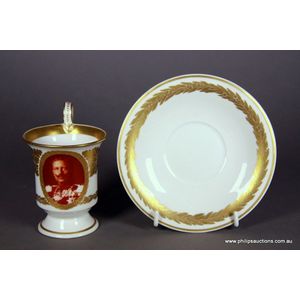Samson Paris Cup & Saucer with Grisaille Landscape Decoration
You must be a subscriber, and be logged in to view price and dealer details.
Subscribe Now to view actual auction price for this item
When you subscribe, you have the option of setting the currency in which to display prices to $Au, $US, $NZ or Stg.
- Grisaille - Decorative painting in monochrome, usually shades of grey, olive green or buff, painted on wood, plaster, ceramic or stone surfaces to imitate marble figural sculpture or relief ornament.Grisaille, from the French "gris", or grey (colour) is a painting technique in which a monochrome image is created using only shades of gray, black and white, usually created by using a gray underpainting or a limited colour palette. It is often used to create the illusion of sculpture or relief on a flat surface, and was commonly used during the Renaissance and Baroque periods.
The technique of grisaille has been used in decorative arts for centuries. It was commonly used in the Renaissance and Baroque periods in Europe to create the illusion of sculptural relief on flat surfaces such as walls, ceilings, and furniture. This technique allowed artists to create the illusion of depth and dimensionality without the use of colour.
During the Rococo period, grisaille was often used in the production of ceramics and porcelain to create finely detailed designs on a white or light-colored surface.
In the 19th century, grisaille continued to be used in decorative arts, particularly in the production of ceramics, both Western and Oriental. - Circa - A Latin term meaning 'about', often used in the antique trade to give an approximate date for the piece, usually considered to be five years on either side of the circa year. Thus, circa 1900 means the piece was made about 1900, probably between 1895 and 1905. The expression is sometimes abbreviated to c.1900.
This item has been included into following indexes:
Visually similar items

Paris porcelain coffee can and saucer with German inscription, early 19th century (small chip to saucer)

A signed Satsuma cup and saucer, Meiji period, 1865-1912, with two character mark of probably Kozan, a floral embellished cup and saucer with delicate gold tracery and gold and black borders, the cup interior and saucer roundel decorated with myriad butter

A KPM Paul Von Hindenburg portrait cup and saucer, circa 1900, pattern 6475, with German iron cross mark, the pedestal cup with scrolled handle having an everted rim, decorated with gilt oak leaf borders and laurel bands, with a photographic portrait of th

A decorated cup and saucer in the manner of Paris Porcelain, 19th century. The Empire footed cup with a waisted neck, flared rim and a scrolling handle, with a painted scene of figures and buildings beside a lake within a scale decorated gilded border, wit
